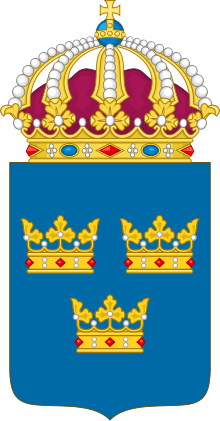Three Crowns



Three Crowns (Swedish: Tre Kronor) is a national emblem of Sweden, present in the Coat of Arms of the Realm of Sweden, and composed by three yellow or gilded coronets ordered two above and one below, placed on a blue background.
The emblem is often used as a symbol of authority by the Swedish government and by Swedish embassies around the world, but also appears in other less formal contexts, such as the Swedish national men's ice hockey team, who wear the symbol on their sweaters and hence are called "Three Crowns" (usually blue crowns on yellow shirt), and atop the Stockholm City Hall built 1911-1923. The Three Crowns are also used as the roundel on military aircraft of the Swedish Air Force and as a sign on Swedish military equipment in general.
Origins
The origin of the symbol has been much debated throughout history and various more or less well-founded theories have attempted to shed some light on the matter.
The symbol is known to have been placed atop the mighty central tower of the castle Tre Kronor in Stockholm, destroyed by fire in 1697, no later than the early 16th century. The symbol, however, is known to be quite older. One of several traditional explanations have suggested Albrekt of Mecklenburg (1338-1412), who ruled Sweden 1364-1389, brought the symbol from Germany as a sign of his reign of Sweden, Finland and Mecklenburg. This theory has, however, been refuted by later research, namely, the announcement in 1982 of the discovery of a frieze in Avignon in southern France, estimated to date back to 1336. The frieze was painted for an international congress lead by the Pope and contains the symbols of all participant countries, including Sweden. This discovery suggests the symbol was introduced by Albert's precursor Magnus Eriksson (1316-1377). Magnus used the symbols frequently, probably to mark his three kingdoms; Sweden, Norway and the scanian provinces that he had recently bought from count Johan of Holstein. One should observe that the use of the 3 crowns symbol to indicate Sweden predates the Kalmar Union, which included Sweden, Denmark and Norway.
Another theory suggests that the three crowns in the coat of arms are the three kingdoms: Kings of Svears, Götars och Vends; Sveriges, Götes och Vendes Konung/Finland)
Other three crown designs
Practically identical to the three crowns of Sweden, is that of the flag and crest of the Province of Munster, a region in the south west of Ireland. Like the Swedish model, it comprises two crowns above and one below. These represent the three great duchies of the province, Desmond, Ormond and Thomond. The design was used as the flag of the Lordship of Ireland between 1171-1541 following the Norman invasion of Ireland until being replaced by the flag of the Kingdom of Ireland.
A similar three crowns design is the crest of the city of Kingston-upon-Hull, a large port in Yorkshire, England. This design sees the three crowns stacked vertically and relates back to the Royal charter of 1299. The emblem is used by the city council and the city's two rugby league teams.
The flag of St Edmund consists of three gold crowns on a field of blue (Azure, three crowns Or).[2]
The first corporate coat-of-arms was granted in 1439 to the Drapers' Company in London with three triple crowns. Three crowns also form the logo of Coutts & Co, the London based private bankers, but in this case the design comprises one crown at the top, with two below.
See also
References
- ^ Rune Lindgren (1992). "Varifrån härstammar Tre Kronor-symbolen?". Gamla stan förr och nu (in Swedish). Stockholm: Rabén & Sjögren. p. 17. ISBN 91 29 61671 9.
- ^ Perrin, W.G. (1922). British Flags. Cambridge: Cambridge University Press.
{{cite book}}: Cite has empty unknown parameter:|coauthors=(help)
